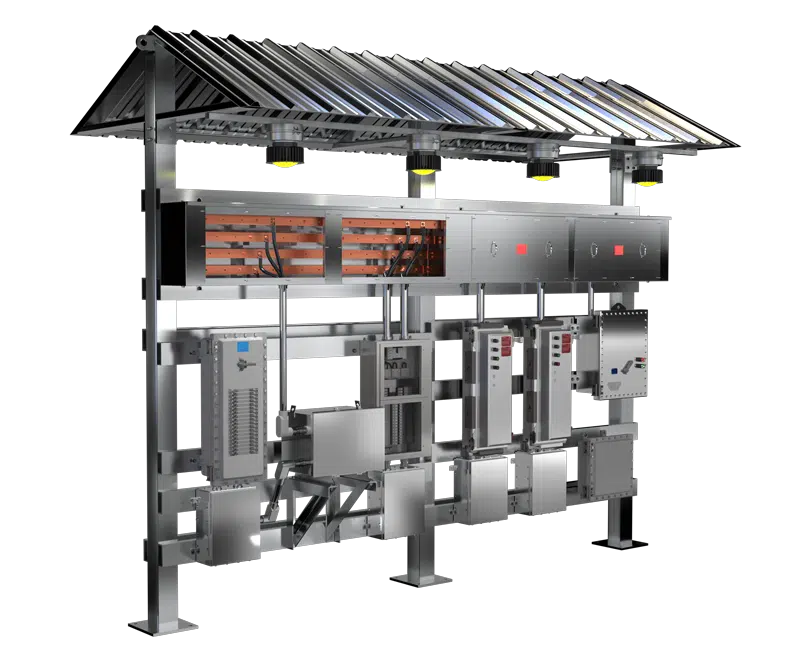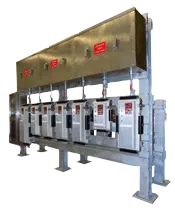
In the hazardous location (HazLoc) industry, ensuring electrical installations meet stringent engineering standards isn’t just a regulatory formality—it’s an absolute necessity for safety, reliability, and operational integrity. This blog delves into the meticulous engineering behind code-compliant switchrack solutions, with insights drawn from industry standards, specifically IEEE guidelines, and practical applications seen at Spike Electric Controls.
What Defines a Code-Compliant Switchrack?
A switchrack, as defined by IEEE, is an engineered assembly comprising circuit breakers, motor starters, transformers, panelboards, and various control equipment integrated onto a free-standing metal structure. These structures serve critical roles in safely managing electrical distribution in classified hazardous locations such as petrochemical and refining plants.
A truly compliant HazLoc switchrack adheres to detailed standards outlined by IEEE and UL, considering structural integrity, electrical reliability, environmental safety, and maintenance ease.
Structural Engineering Considerations
The first critical factor in designing compliant HazLoc switchracks is structural integrity. Switchracks must be engineered to withstand environmental stresses such as seismic activities and wind loads. IEEE guidelines emphasize selecting robust vertical supports, typically structural I-beams, paired with horizontal supports like C-channels. These structures are generally fabricated from materials like galvanized steel or aluminum, ensuring corrosion resistance and long-term durability.
Spike Electric Controls exemplifies this rigorous approach by custom engineering each switchrack with detailed structural analyses and design considerations. Structural weld integrity, precise alignment, and the use of durable materials guarantee that the final product withstands extreme conditions inherent to hazardous environments.
Comprehensive Bus Duct Systems
The heart of any switchrack is its bus duct system, engineered for reliability and electrical integrity under fault conditions. IEEE standards require that bus ducts be designed to handle maximum short-circuit currents with minimal damage. Copper bus bars within these ducts must be adequately braced, insulated, and plated (typically with tin or silver) to ensure optimal conductivity and protection against corrosion.
Spike Electric Controls takes this design principle further by ensuring each bus duct system meets stringent IEEE and UL criteria, extensively testing each assembly for insulation resistance, continuity, and structural robustness before shipment.
Adhering to Area Classification Standards
Accurate area classification is fundamental to code compliance. HazLoc switchracks must be designed explicitly for their designated environment, whether Class I Division 1, Class I Division 2, or other specified hazardous classifications. IEEE standards clearly define how electrical enclosures, conduit systems, and sealing methods must be tailored to specific hazardous locations to prevent the ignition of explosive atmospheres.
Spike Electric integrates precise area classifications into every design. Specialized enclosures, explosion-proof fittings, and appropriate conduit seals are used consistently, ensuring switchracks remain safe and functional regardless of hazardous area modifications over the lifecycle of the facility.
Electrical System Compliance and Safety
Code compliance extends deeply into the electrical configuration of HazLoc switchracks. IEEE recommendations detail the necessity of properly rated circuit breakers, fault protection mechanisms, and thorough grounding systems. Additionally, switchracks must employ comprehensive safety measures like arc flash protection and proper labeling to protect operators and maintenance personnel.
Spike Electric Controls meticulously follows these safety recommendations, employing robust grounding systems and clearly labeled protective devices. Each switchrack undergoes rigorous factory acceptance testing, including coordination studies, protective device testing, and torque checks, ensuring every unit meets exacting safety and operational standards.
Maintenance-Focused Engineering
Engineering for compliance also means facilitating ease of maintenance and inspection. IEEE and NFPA 70B standards specify that switchrack designs should allow straightforward accessibility for inspections, thermal imaging, and preventive maintenance procedures. This approach significantly enhances the reliability and safety of the equipment throughout its operational lifespan.
Spike Electric incorporates these maintenance-centric engineering principles by ensuring open access points for inspections, corrosion-resistant materials for long-term durability, and clearly documented maintenance protocols. The outcome is reduced downtime, simplified servicing, and enhanced overall safety.
Economical and Operational Benefits
Adhering to IEEE compliance standards isn’t solely about safety—it’s also about achieving long-term operational and economic benefits. Compliant switchracks significantly reduce risks of unscheduled outages, costly retrofits, and potential safety incidents. By adopting compliant engineering practices from the outset, companies realize substantial long-term savings through reduced downtime, lower maintenance costs, and improved reliability.
Spike Electric Controls underscores these benefits by providing turnkey solutions engineered explicitly for operational efficiency, cost-effectiveness, and strict adherence to safety regulations. Pre-tested and ready-to-install switchrack solutions from Spike streamline commissioning processes, minimize field installation challenges, and provide enduring operational value.
Conclusion: Setting the Standard with Spike Electric
Understanding and applying IEEE and UL compliance standards ensures that HazLoc switchracks meet and exceed critical safety and reliability benchmarks. Spike Electric Controls’ engineering expertise exemplifies the rigorous application of these standards, providing solutions tailored precisely to the demands of hazardous location environments.
By prioritizing structural integrity, precise electrical engineering, comprehensive safety protocols, and ease of maintenance, Spike Electric’s switchrack solutions consistently demonstrate why code compliance is not optional—it is essential. Embracing these standards ensures not only compliance but also maximized safety, reliability, and financial efficiency for industries operating within hazardous environments.


